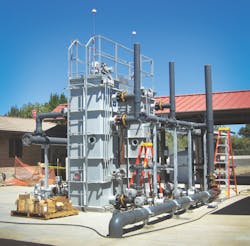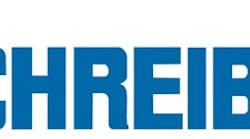The Graton Water Resource Recovery Facility (WRRF) in Sonoma County, Calif., is owned and operated by the Graton Community Service District (GCSD). GCSD was mandated in 2004 to upgrade its 1979 secondary aerated lagoon to tertiary discharge standards.
Before considering the most economical upgrade option for GCSD, Lescure Eng. of Santa Rosa, Calif., evaluated the biological treatment capacity of the existing lagoon system. It was determined that the lagoons have sufficient capacity to deliver effluent meeting the numerical biochemical oxygen demand (BOD) limit for tertiary effluent. Lescure Eng. helped GCSD save significant capital and operating cost by keeping the existing secondary treatment system and installing a new tertiary treatment system. The tertiary treatment system included three technologies: suspended air flotation (SAF) from Heron Innovators, Fuzzy Filter compressible media filters from Schreiber LLC and disinfection from Pasteurization Technology Group (PTG). This treatment process produced two valuable products for GCSD: tertiary disinfected reclaimed water and compost suitable for unrestricted applications. GCSD’s new tertiary facility started producing Title 22 tertiary disinfected effluent in March 2014. This article will discuss the successful implementation of the Fuzzy Filter at GCSD WRRF.
Design Objectives
The design of the Graton WRRF was governed by California regulations commonly referred to as Title 22, administered by the state Department of Public Health. The filtration system must be designed to Title 22 standards, which have strict requirements on influent and effluent quality. The filter influent turbidity should not exceed 10 ntu more than 5% of the time within a 24-hour period and should not exceed 15 ntu at any time. The filter effluent should have an average of 2 ntu within a 24-hour period, should not exceed 5 ntu more than 5% of the time within a 24-hour period, and should not exceed 10 ntu at any time.
Lescure Eng. evaluated various filtration technologies, including cloth media and compressible media filters. The evaluation of the filtration technologies was based on criteria set by GCSD, including reliable operations, small footprint, operator friendliness, minimal chemical cleaning and low maintenance requirements.
GCSD selected the Fuzzy Filter for further pilot-scale evaluation. To ensure that the compressible media filter would operate within Title 22 limits of upstream turbidity (less than 10 ntu), an upstream clarification process with coagulation and flocculation was required for algae removal. The clarification process was necessary to ensure reasonable filtration runtimes between backwashes. SAF was selected by GCSD as the most efficient process for the removal of algae from pond water. Successful pilot testing of SAF followed by the Fuzzy Filter demonstrated that the tertiary treatment system could meet Title 22 water clarity requirements.
A New Tertiary Treatment System
The new tertiary treatment system at GCSD was designed for wet-weather flow of 0.505 million gal per day (mgd) and dry weather flow of 0.288 mgd. It consists of a transfer wet well, where effluent from a settling pond is pumped into a chemical mix tank upstream of the SAF unit. A coagulant is metered into the mix tank and a flocculant is injected into the gravity line between the bottom of the mix tank and the influent point of the SAF flotation cell. A froth containing 40% air by volume is fed into the influent point of the SAF flotation cell to produce very small air bubbles capable of floating solids particles and algae into the surface of the SAF unit. The froth is produced from a proprietary SAF froth generator, where a surfactant is fed into the froth generator and diluted with plant water. The clarified effluent from the SAF unit flows by gravity into a surge tank, which serves as the influent to the filters. Filtered effluent flows by gravity into a purge tank, which also is used for backwashing the filters. Filter effluent is pumped from the purge tank into the pasteurization unit for disinfection before it is discharged into the holding ponds.
The Fuzzy Filter uses a filtration media that is highly porous—with porosity higher than 85%—and compressible. The filter media consist of proprietary synthetic-fiber porous material made of polyphenylene sulfide, and are retained between two perforated plates. The lower perforated plate is fixed, and the position of the upper perforated plate is adjusted at the beginning of a filtration cycle to obtain the desired medium compression ratio. The average medium compression ratio is defined as one minus the ratio of compressed medium depth to uncompressed medium depth. For example, to compress the medium 40%, the compression plate is lowered until the medium thickness is 18 in. when the initial uncompressed medium depth is 30 in. Properties of the filter medium—such as bed depth, collector size and porosity—can be adjusted between 0% and 40% compression ratio depending on the influent and desired effluent quality. For GCSD, the optimum compression ratio determined by pilot testing was 15%.
The compressible media filter is able to operate at greater filtration rates, while the head loss development is comparable with other types of filters because of the low interstitial flow velocities. Because of the high porosity of the filter bed, significantly higher filtration rates (30 to 40 gpm per sq ft) can be used effectively. The higher filtration rate is translated into a smaller footprint. In addition, secondary effluent can be used as backwash water (with a backwash rate of 10 gpm per sq ft considered sufficient for the cleanup of the medium), eliminating the need for separate piping and valves. The Fuzzy Filter has low backwash reject water (BRW) ratio values, ranging from 2% to 6%. BRW ratios larger than 10% generally are considered excessive and can hinder the feasibility and overall production of the WRRF. The filter helped GCSD to reduce its capital and operating costs.
At GCSD WWRF, there are two Fuzzy Filter units; each is 3 by 3 ft, which provides a total filtration area of 18 sq ft. Each filter unit includes 30 in. of uncompressed media. At a filtration rate of 30 gpm per sq ft, the system can filter up to 540 gpm with both units in filtration mode. However, the GCSD is designed for a peak flow of 400 gpm, which corresponds to a filtration rate of 22.2 gpm per sq ft.
Filtration & Backwash Cycles
During the filtration cycle, SAF effluent is introduced at the bottom of the filter in a plenum chamber. The inlet plenum is used to improve flow distribution through the filter bed. Influent flows up through the filter media and is discharged from the top of the filter. The filtration cycle is interrupted for backwashing when head loss through the filter media reaches a preset maximum allowable level (terminal head loss) or effluent quality deteriorates to an unacceptable level (greater than 2 ntu). Generally, the filters at GCSD backwash due to media pressure drop before solids breakthrough begins.
At the inception of the backwash cycle, the filtered water discharge valve is closed, flow is diverted to the backwash water line and the upper perforated plate is raised. While SAF effluent continues to flow up through the filter at a reduced flow rate of 120 gpm, air is introduced below the lower perforated plate, first from the left and then the right side of the filter, sequentially. Air introduced in the plenum creates turbulence and shear forces as it moves up through the expanded filter bed, which helps scour and remove accumulated material from the filter media. BRW is returned to the ponds. Before starting the next filtration cycle, the upper perforated plate is returned to its predetermined compressed position and the filter is purged to waste with filtered water. The filter-to-waste is continuously monitored with an on-line turbidity meter until the filtered effluent turbidity is 2 ntu or less. At that time, the filter is returned to service for the production of tertiary water. The complete backwash cycle with filter-to-waste takes approximately 30 minutes.
Successful Performance
The installed Fuzzy Filter system at GCSD WRRF has reliably produced high-quality effluent with turbidities of less than 2 ntu with relatively long filtration cycles. Each filter unit achieved more than seven hours of continuous filtration between backwashes with turbidities of less than 1 ntu. Filter backwashes were triggered by an increase in filter head loss (bottom of media bed pressure).
The capability of the tertiary treatment system in achieving high BOD and total suspended solids (TSS) removal and producing high-quality disinfected reclaimed water was demonstrated in recent full-scale testing at a peak flow of 400 gpm. BOD5 and TSS removal after filtration (based on pond effluent) were approximately 99%, well in excess of the 85% requirement. Filtered effluent BOD5 and TSS concentrations were less than 5 mg/L, with turbidity less than 1 ntu. Coliform in PTG effluent was less than 2 most probable number per 100 mL.
The operational flexibility and reliability of the filter at the WRRF enables GCSD to produce high-quality effluent that meets and exceeds Title 22 effluent requirements. According to Bob Rawson, GCSD’s general manager, “The new tertiary treatment system helped the district meet its goal of complete-removal system, leaving no residuals needing further cleanup and providing us with valuable tertiary disinfected reclaimed water.”
Download: Here



